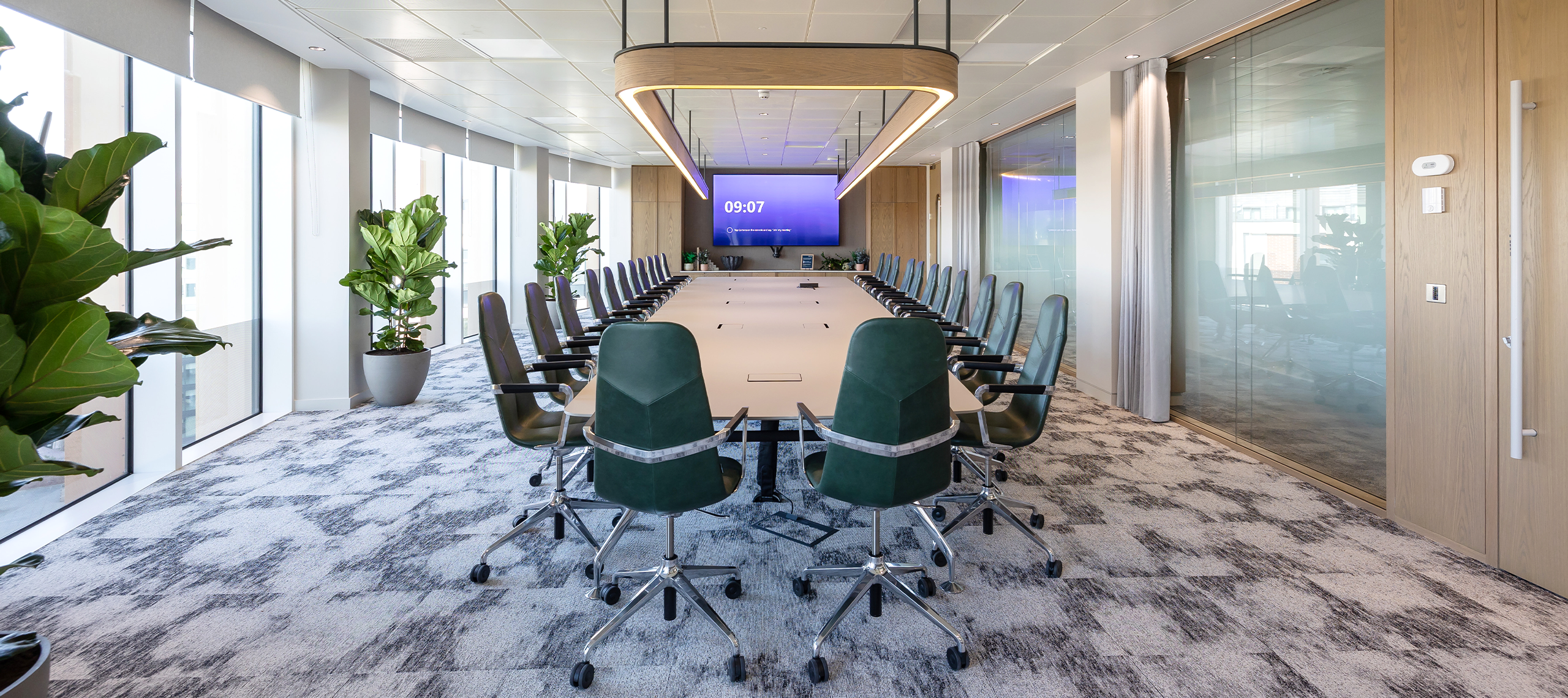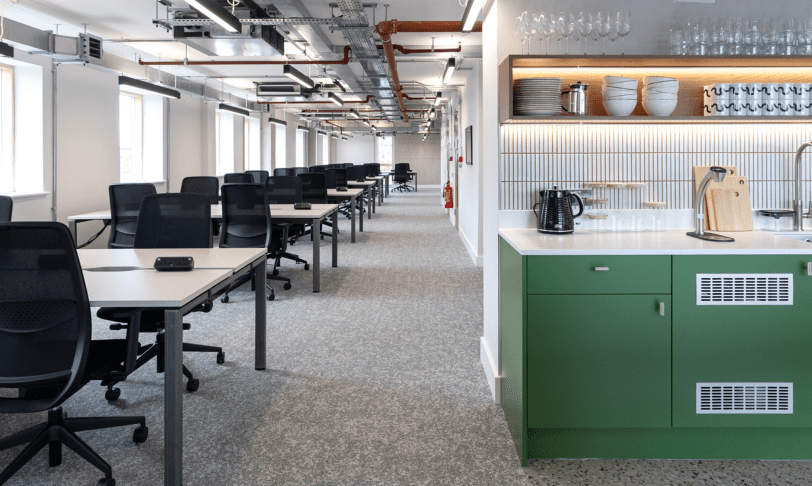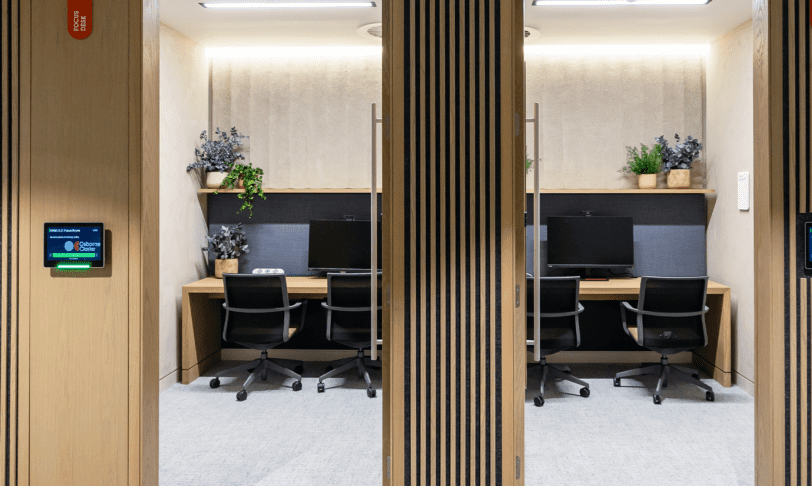Engineering better workplaces: balancing precision, security, and people
Aerospace, defence and nuclear firms are core to the UK’s economic strength and global reputation. In 2023, these sectors collectively contributed £38.2 billion in value to the UK economy, with the UK aerospace sector alone worth over £30 billion, having seen a 14% growth over ten years.
These organisations often deal with high-stakes, highly regulated work – where security, precision, and performance are essential. As these sectors continue to evolve – under pressure from talent shortages, digital transformation, and growing ESG responsibilities – the role of the workplace is changing too.
In sectors like aerospace, defence, and nuclear, the workplace becomes a critical component of operational success. These industries demand environments that uphold stringent security standards, facilitate complex workflows, and support highly skilled professionals. But, in 2025, offices are no longer just where work happens; they’re part of a wider strategy to attract top talent, safeguard critical IP, and support cutting-edge collaboration.
So, what does a well-designed workplace look like in these environments?
Designing for security, without compromise
Security is already baked into the culture of aerospace, defence and nuclear organisations. But traditional offices aren’t always built with that level of protection in mind. For these companies operating at the cutting edge of technology and engineering, office design needs to enable secure collaboration, safeguarding sensitive data, and meeting rigorous technical standards.
Specialist infrastructure is often non-negotiable. Many teams require secure areas for classified conversations or data handling, which may mean designing in SCIF-style zones (Sensitive Compartmented Information Facilities), incorporating Faraday cages to block electromagnetic interference, or installing List X ready spaces to ensure compliance with secure data transmission standards. More than just convenient extras, these features are foundational to enabling maximum productivity and innovation.
GKN Aerospace
At GKN Aerospace’s global technology centre, we created a List X-compliant environment on the top floor, designed to meet stringent government security requirements. This included the integration of a Faraday cage, providing complete electromagnetic shielding for secure discussions and equipment use. The wider building was designed with layered security in mind – from full access control and ANPR-connected entry barriers, to comprehensive CCTV coverage and intruder detection systems. Every detail, from visitor flow to system redundancy, was designed to support GKN’s role as a critical supplier to the defence and aerospace industries.
Beyond digital security, acoustic protection is a frequent requirement, whether for sensitive R&D discussions or to shield classified project areas from adjacent workspaces. High-spec partitions, acoustic insulation and electronic masking systems are design considerations from day one, not last-minute additions.
Redundancy and resilience are also key. Backup power systems, specialist cooling, and environmental monitoring are operational essentials. Workspaces may need integrated systems that support 24/7 secure access, monitored entry points, and restricted zones, all without compromising user experience for day-to-day staff.
Add to that the increasing requirement for compliance with government and defence standards – from Cyber Essentials to MoD-grade physical security – and it’s clear that your average office fit-out won’t cut it.
In short, technical environments demand a workplace partner who understands the implications of working in these sectors, not just from a compliance perspective, but from a cultural one too. The workplace needs to reflect and reinforce the seriousness of your mission, without getting in the way of innovation, productivity or wellbeing.

Supporting complex, critical work
Unlike standard commercial offices, aerospace, engineering, defence, and nuclear companies operate with extremely specialised workflows. Their spaces need to support everything from highly confidential design programmes to prototype assembly and hands-on technical collaboration. Specialised equipment, secure data handling, and stringent compliance requirements are all part and parcel of these companies, and the office needs to support that.
Technical office design needs to consider:
- Integrated technical workshops – many engineers in these industries work in hybrid environments, and may need flexible spaces that support both CAD modelling and hands-on work with 3D printers, composites, or mechanical assemblies. These spaces must be ventilated, supplied with enough power, and often vibration-isolated.
- Proximity between design and development functions – it’s also important to consider the location of these work areas, such as co-locating CAD stations near prototyping areas, or ensuring project teams can physically gather around plans, models or components.
- Specialist technical zones – from tool-safe worktops to robust power distribution and equipment-ready layouts. Anti-static flooring is also critical to avoid damaging electronic components, particularly in environments handling avionics or weapon systems.
- Seamless transitions between secure and non-secure areas – allowing collaboration without compromising control.
- High-load bearing floors – equipment like server racks, testing rigs, and storage for prototypes may require reinforced flooring.
These kinds of requirements may be common across the sector, but they need to be planned in from the outset to allow for maximum innovation and productivity.
Offices that help attract and retain top talent
The aerospace and defence sectors are facing a significant talent crunch. According to McKinsey, these industries are grappling with a wave of retiring workers and struggling to attract skilled personnel to take their place. By 2030, the UK’s defence and aerospace sectors will require more than 100,000 new professionals to keep pace with industry needs.
And with companies like Rolls-Royce, Airbus and BAE Systems competing globally for talent, the challenge isn’t just finding qualified candidates; it’s about creating environments that appeal to the next generation of engineers and technical experts.
Thales reported that 49% of UK companies in sensitive sectors experienced a security breach linked to remote or hybrid work. This finding highlights a growing concern about the cybersecurity risks associated with distributed work environments, and as many companies may be considering a return-to-office mandate to bolster security, it’s important to consider what kind of environment employees are returning to.
Younger engineers and specialists increasingly expect:
- Access to cutting-edge facilities – not just tools, but inspiring, functional spaces to solve complex problems.
- Areas for collaboration – this new generation of talent need areas where they can learn from their colleagues, particularly their seniors. Open collaboration areas and spaces for learning are key.
At GKN Aerospace, we built an auditorium capable of holding audiences of 100 that backs onto a “hack space”, where employees of all levels are encouraged to collaborate, innovate and work on complex challenges together.
- Workplaces with purpose – places that reflect a company’s values, commitment to sustainability, and investment in people.
- Support for personal and professional growth – including quiet zones for focused work and spaces for collaboration. Think libraries, knowledge sharing hubs and simulation rooms.
- A focus on wellbeing – working at the cutting edge of nuclear tech or defence engineering can be stressful. Prioritising breakout spaces allows employees to take a proper break from their work, whilst other amenities such as gyms, yoga studios or wellbeing rooms help keep employee wellbeing at the forefront.
Another key consideration when designing technical offices to attract top talent is to create inclusive spaces to attract a more diverse future workforce – critical in industries still working to close gender and ethnicity gaps. According to McKinsey, inclusive organisations are 35% more likely to outperform their peers. That starts with creating spaces where everyone feels they belong. This includes accessible meeting rooms, multi-faith spaces, gender-neutral toilets, breastfeeding spaces, and neurodivergent-friendly design features.
For sectors that can’t always offer total location flexibility due to the nature of the work, the office needs to work harder to deliver on experience.

Making space work harder
The impWith every square foot under scrutiny – whether due to cost, ESG reporting or security risks – workspace efficiency matters more than ever. For high-complexity sectors, that might mean:
- Replacing underused meeting rooms with flexible project war rooms.
- Designing flexible zones that can evolve with changing teams
- Creating robust remote collaboration spaces that support hybrid engineering work.
None of this means sacrificing quality – it means being intentional about how space supports the organisation’s wider mission.
Aligning workplace strategy with ESG goals
Not Many organisations in these sectors are under pressure to meet ambitious ESG targets, improve supply chain transparency, and support the UK’s industrial decarbonisation strategy. The workplace can – and should – be part of that strategy.
Some forward-thinking approaches we’re seeing include:
- Certifications that signal commitment, such as BREEAM, WELL, SKA or RESET, which can help attract both future talent and responsible investors.
- Low-carbon and circular fit-outs aligned with science-based targets: incorporating reused materials, low-VOC finishes, and demountable systems that allow for future reconfigurations with minimal waste.
- Localising supply chains for furniture, joinery and materials to support UK manufacturing and reduce emissions from transport – especially important for companies already under Scope 3 scrutiny.
- Embedding digital building management systems to track energy and water use in real time, crucial for both operational efficiency and regulatory reporting.
Biophilic design elements to support wellbeing, increase productivity, and reduce stress in high-pressure environments – particularly effective in windowless or secure spaces where access to nature is limited.
Ready to make your office a strategic asset?
Workplaces in aerospace, defence and nuclear industries are more than just places where people go to work. Done right, they’re tools for recruitment, innovation, compliance, and culture.
The demands are high – but so is the opportunity. When workplace design is approached with the same precision and ambition as the products these industries create, your office could become a strategic asset.
Interested in learning more about our expertise in designing workspaces that combine rigorous security with employee experience? Get in touch with us today.



